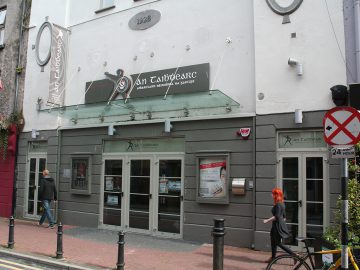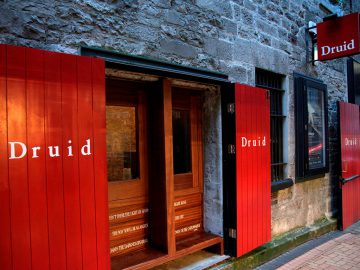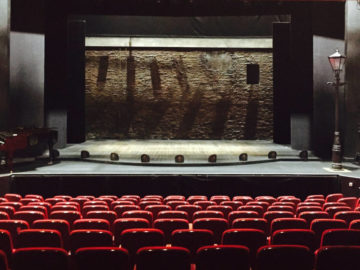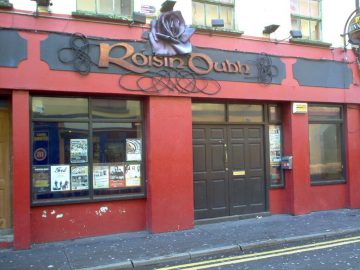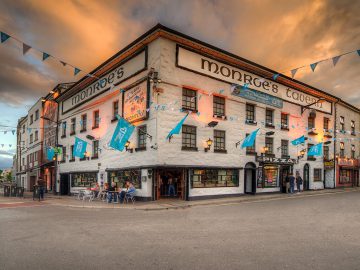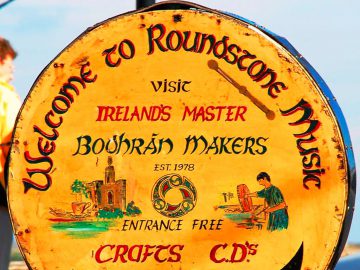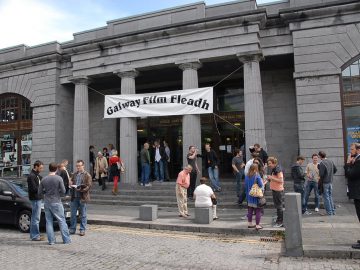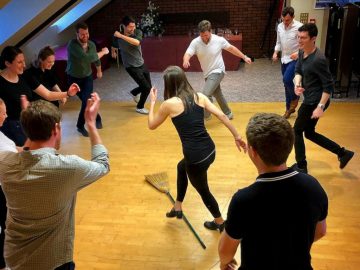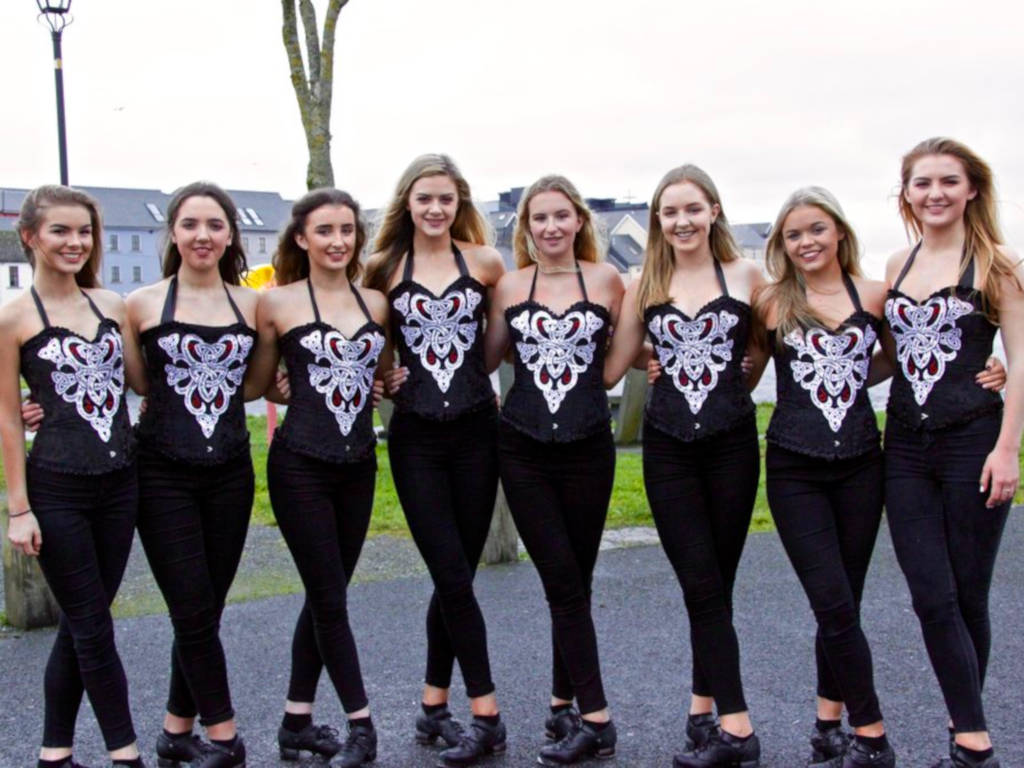
Traditional Irish Dancing
Discover Sean Nós, Céilí, Set and Step Dancing in Galway
Everyone in Ireland remembers the moment during the Eurovision Song Contest in 1994 that Jean Butler burst onto the stage. In just seven minutes Riverdance was born; Irish dance was brought into the 21st century and has never looked back. More recently Ed Sheeran’s video for Galway Girl featured a cameo appearance from a Irish dancing troupe from the Hession School of Irish Dancing based in Salthill giving it their all on the streets of Galway and bringing Irish dancing to a worldwide audience once again.
Irish Dancing Shows
If you would like to see Irish dancers there are festivals, fleadhs, céilís and Irish dancing championships held all round county Galway throughout the year along with shows like Trad on the Prom, based in Leisureland Theatre or Mise Éire with shows in The Taibhdhearc theatre and The Galmont Hotel and Spa in Galway City. Both Irish music and dance shows generally run during summer months until October.
Learn Irish Dancing
Maybe you want to take part in céilís or set dancing or get Irish dancing lessons yourself? Find out more from An Coimisiún le Rincí Gaelacha (the Irish Dancing Commission), from Comhaltas Ceoltóirí Éireann, the organisation for promoting traditional Irish music and culture, or from Oideas Gael, which offers Irish dancing workshops as one of its cultural activity holidays. Irish dance classes are also available at The Irish Dance Experience.
Don’t miss seeing Galway’s own resident sean nós dancing expert, Emma O’Sullivan who often demonstrates Irish dancing at High Street in Galway entertaining crowds with her unique and special talent.
Background of Traditional Irish Dancing
Irish dancing is a traditional style of dance that originated in Ireland. It is characterized by its energetic and rhythmic movements, which are often performed to the accompaniment of Irish music. Irish dancing has become popular worldwide, thanks in part to shows like Riverdance and Lord of the Dance, which helped to showcase the art form to a global audience.
There are several different styles of Irish dancing, but the two most well-known are the step dancing and ceili dancing. Step dancing is performed solo and is known for its intricate footwork, with dancers typically wearing hard shoes to create a percussive sound. Ceili dancing, on the other hand, is a group dance that is usually performed in sets of four, six, or eight dancers. It is characterized by its lively, upbeat tempo and often involves dancers holding hands and performing synchronized movements.
Irish dancing costumes are also an important part of the tradition. Female dancers typically wear a brightly colored dress with a full skirt, while male dancers wear a jacket, vest, and pants, along with either soft or hard shoes depending on the style of dance.
Irish Dancing FAQs
What are the different styles of Irish dancing?
Irish step dancing: This is perhaps the most well-known style of Irish dancing, and it involves intricate footwork and a rigid upper body posture. Dancers often wear elaborate costumes and perform in groups, with the emphasis on precise timing and synchronization.
Sean-nós dancing: This is a more relaxed and improvisational style of Irish dancing, characterized by low, shuffling steps and fluid upper body movements. Dancers often perform solo or in small groups, and the focus is on individual expression and interpretation of the music.
Set dancing: This style of Irish dancing is performed in groups of four or more dancers, with a structured set of steps and formations. The emphasis is on coordination and synchronization between the dancers, and there are several different set dances that are commonly performed.
Ceili dancing: This is a social style of Irish dancing, performed in groups of four or more dancers. The emphasis is on having fun and enjoying the music and the company of other dancers, and the steps and formations are usually simpler than those of other styles of Irish dancing.
What are the origins of traditional Irish dancing?
Irish dancing evolved over time, influenced by a variety of factors, including the introduction of Christianity to Ireland in the 5th century and the arrival of the Normans in the 12th century. Dance was often used to celebrate important occasions and milestones, such as weddings, harvest festivals, and religious holidays.
In the 18th and 19th centuries, Irish dance underwent a significant transformation, as it began to incorporate elements of ballet and other European dance styles. This led to the development of the distinctive Irish step dancing style that is now so closely associated with Ireland and its culture.
In the 20th century, Irish dancing experienced a resurgence in popularity, fueled in part by the success of Irish dance shows and competitions such as Riverdance and Lord of the Dance. Today, Irish dancing remains an important part of Ireland’s cultural heritage, celebrated around the world for its intricate footwork, lively rhythms, and unique style.
What is the best Irish dancing show in Galway?
The show takes place in the Leisureland theatre and features a cast of over 20 performers, including musicians, singers, dancers, and storytellers. The performers are all experts in their fields, and the show features everything from traditional Irish music and dance to modern interpretations of these art forms. Many of the performers previously toured with world renowned Irish dance shows such as Bill Whelan’s ‘Riverdance’ and Michael Flately’s ‘Lord of the dance’.
Trad on the Prom is known for its high-energy performances, intricate footwork, and vibrant costumes. The show also incorporates elements of Irish mythology and storytelling, adding an extra layer of depth and meaning to the performances.
One of the highlights of the show is the Irish dance performances, which are performed by some of the best Irish dancers in the world. The dancers perform intricate footwork and complex choreography, accompanied by live music from some of the top Irish musicians.
What is the most popular Céilí band in Ireland?
The band takes its name from the village of Kilfenora in County Clare, Ireland, which is known for its rich musical heritage. Over the years, the Kilfenora Céilí Band has become synonymous with the music and dance traditions of Ireland, and has performed for audiences around the world.
The band’s music is rooted in the traditional music of Ireland, and includes a mix of jigs, reels, hornpipes, and other traditional tunes. They are known for their high-energy performances, which feature intricate melodies and lively rhythms that are perfect for dancing.
In addition to their music, the Kilfenora Céilí Band is also known for their dedication to preserving and promoting the traditional music and dance of Ireland. They have taught countless workshops and classes, and have helped to inspire a new generation of Irish musicians and dancers.
Today, the Kilfenora Céilí Band is still going strong, and continues to be one of the most popular and respected traditional music groups in Ireland. They have released numerous albums over the years, and have won numerous awards and accolades for their contributions to Irish music and culture.
